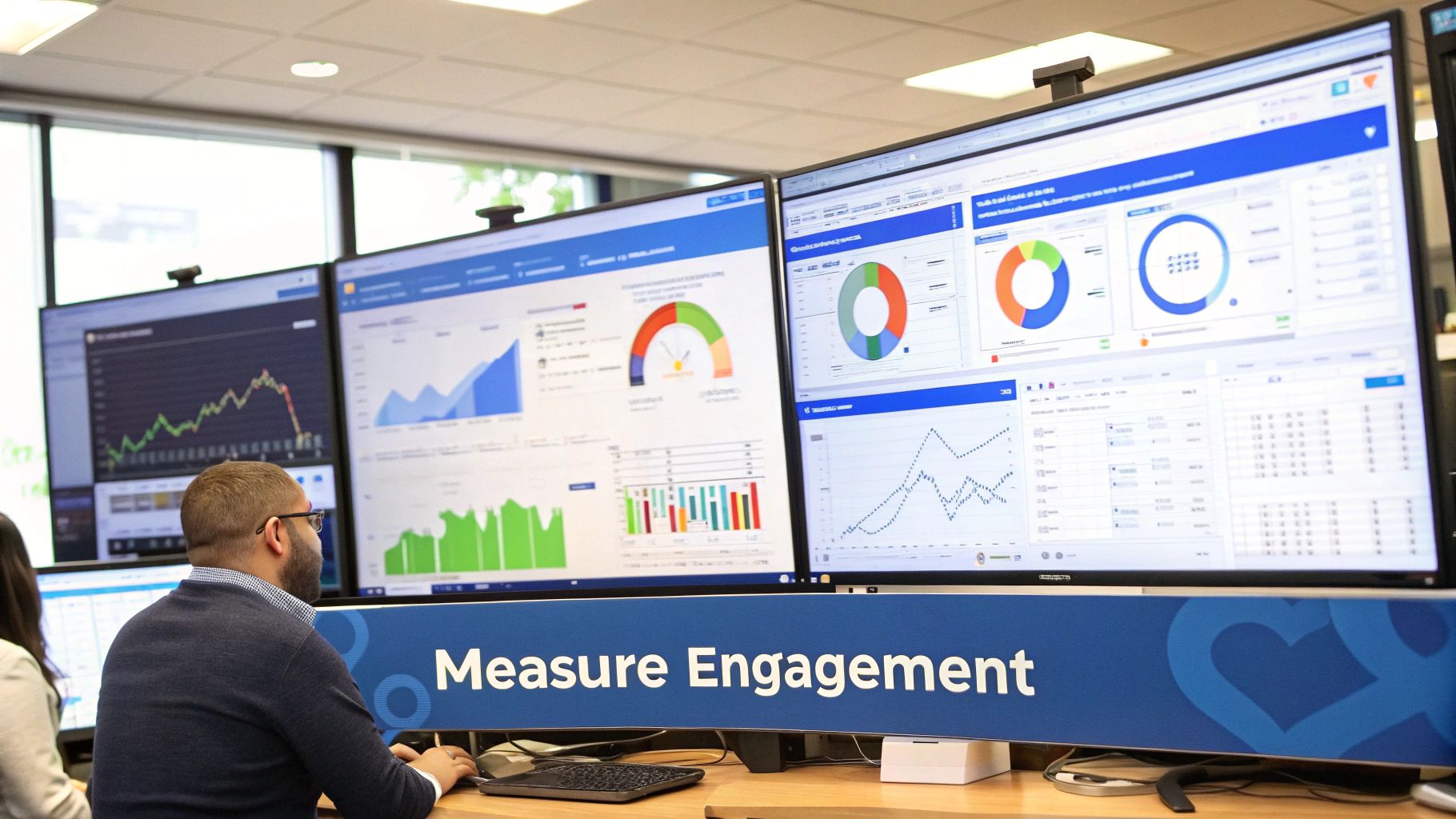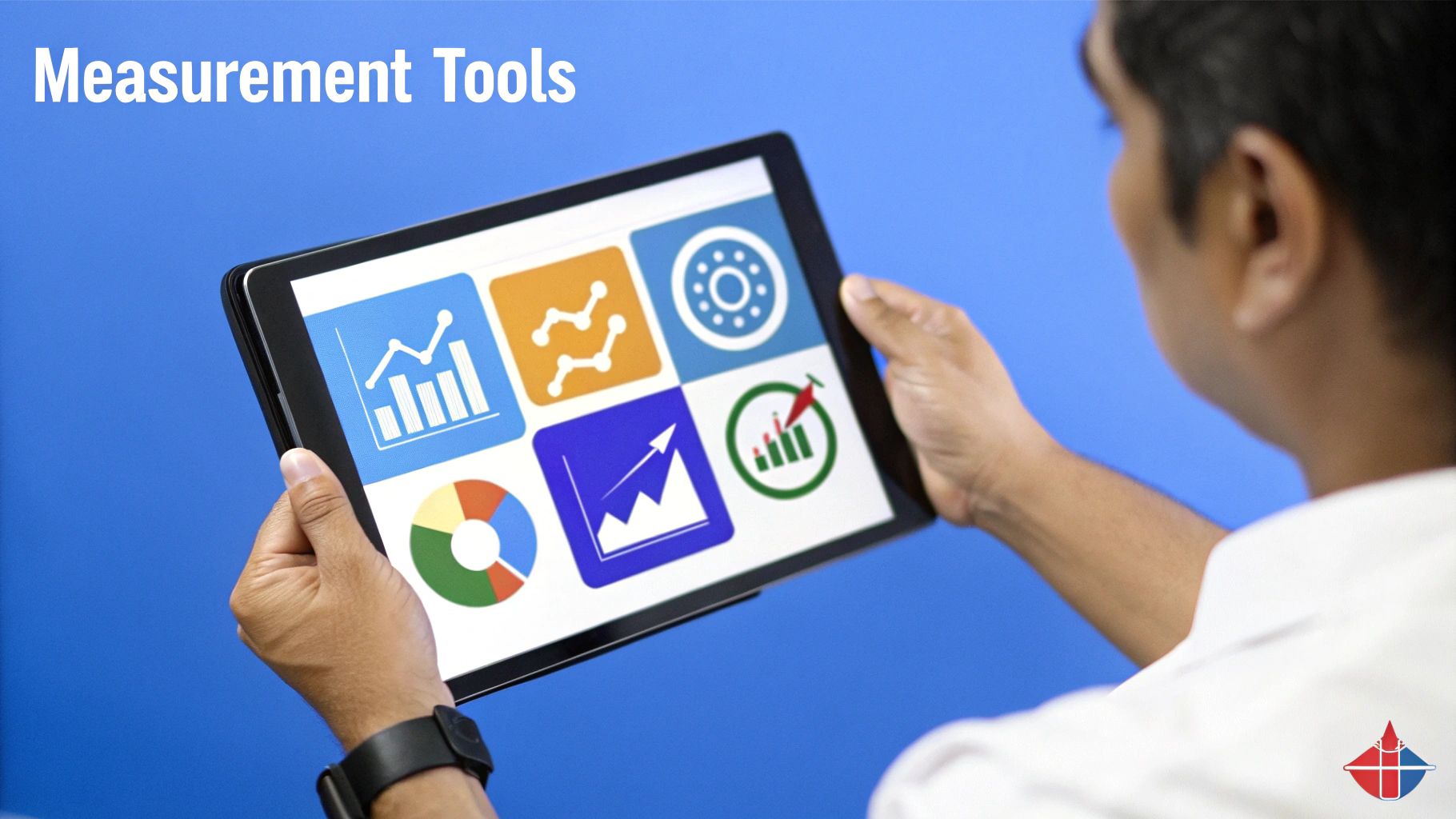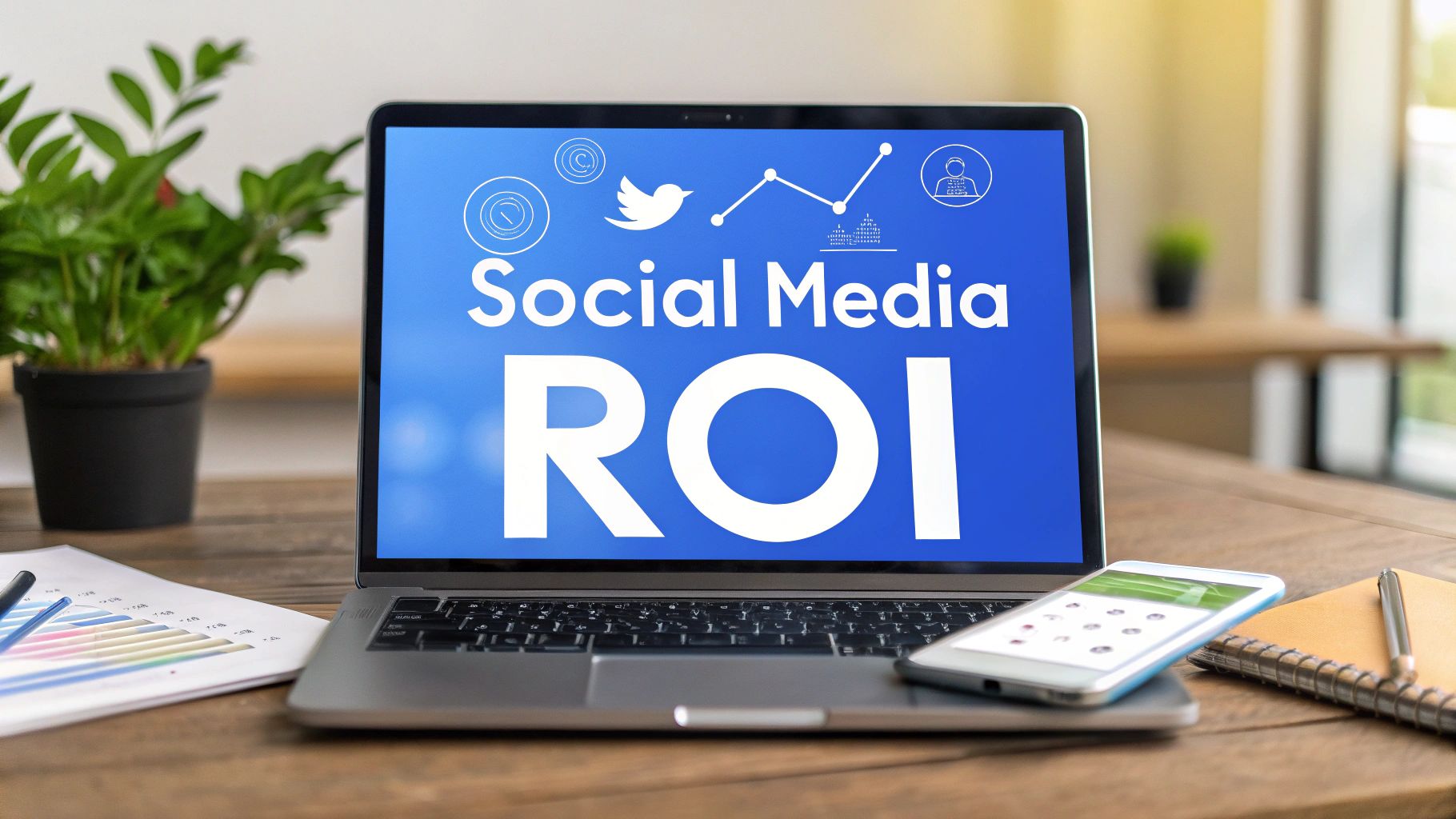Why Most Social Media ROI Measurements Fail
Many businesses find it challenging to demonstrate a tangible return on investment (ROI) from their social media marketing. This isn't because social media is inherently ineffective, but rather because many companies focus on measuring the wrong things. Traditional metrics like likes, shares, and follower counts are often mistaken for success indicators.
These vanity metrics offer minimal insight into how social media activities are actually impacting the bottom line. Focusing on these surface-level measurements can lead to misinterpretations of campaign effectiveness and wasted marketing spend. Companies may be investing in strategies that generate engagement but fail to drive significant business outcomes.
The Problem With Vanity Metrics
Vanity metrics can create a false sense of accomplishment. A post with thousands of likes might seem successful, but if those likes don't translate into website visits, leads, or sales, the business hasn't realized any tangible benefit. This disconnect between engagement and business outcomes is a key reason why so many social media ROI measurements come up short. Furthermore, fixating on vanity metrics can distract from more important metrics.
These more impactful metrics directly correlate with business goals, such as conversion rates, customer acquisition cost, and customer lifetime value. Overlooking these crucial data points can hinder a company's ability to optimize its social media strategy for genuine, measurable results.
The Shift to Revenue-Focused Measurement
Successful companies understand that social media ROI should be directly tied to tangible business outcomes. They have shifted their focus from vanity metrics to revenue-focused measurement. This means prioritizing data that reflects business objectives, such as tracking conversions, leads, and sales originating from social media channels.
They also recognize that social media plays a significant role throughout the entire customer journey, not just at the final conversion point. Social media contributes to brand awareness, customer engagement, and lead nurturing – all of which indirectly affect revenue generation. Social media platforms, like Facebook, have become essential for driving sales.
In 2025, social networks influenced 17.11% of all online sales globally, demonstrating their substantial impact on e-commerce. This trend is projected to continue its upward trajectory, with the global social commerce sector anticipated to exceed $1 trillion by 2028, growing at a 13.7% compound annual growth rate (CAGR). Find more detailed statistics here: Learn more about social media marketing ROI statistics. Measuring this broader impact provides a more complete understanding of its true ROI.
Setting Realistic Expectations
Measuring social media ROI accurately requires setting realistic expectations. Not every social media activity will directly result in a sale. However, by concentrating on metrics aligned with core business goals and acknowledging the role of social media in the broader customer journey, businesses can gain a more accurate understanding of its true value.
This includes measuring the influence of social media on brand awareness, customer engagement, and lead nurturing, even if these don't immediately translate into a conversion. This shift in perspective allows businesses to fully appreciate the multifaceted benefits of social media and measure its ROI effectively.
The Metrics That Actually Predict Revenue Success

The infographic above illustrates a team defining clear goals, a crucial first step in measuring social media ROI. Similar to any project, establishing clear objectives for social media success is essential for accurate measurement. This means looking beyond superficial metrics like likes and shares and focusing on data that directly impacts your bottom line.
Beyond Vanity: Metrics That Matter
While engagement metrics offer some insights, they don't tell the whole story. A post with thousands of likes, for example, might not generate any leads or sales. True social media ROI lies in metrics that predict and reflect revenue growth. This requires understanding which metrics truly indicate success.
Conversion Rate: This metric tracks the percentage of social media users who complete a desired action. These actions could include making a purchase, signing up for a newsletter, or filling out a lead form. A high conversion rate indicates your social media efforts are effectively driving desired outcomes.
Customer Acquisition Cost (CAC): CAC measures the cost of acquiring a new customer through different social channels. Calculating the CAC for each platform helps identify the most cost-effective acquisition channels.
Customer Lifetime Value (CLTV): CLTV represents the total revenue expected from a single customer throughout their relationship with your business. Understanding the CLTV of social-acquired customers helps assess the long-term profitability of your social media investments.
Learn more in our article about How to master social media engagement.
The following table summarizes key social media ROI metrics, comparing vanity metrics against those focused on revenue, highlighting their business impact, measurement difficulty, and ROI predictability.
Key Social Media ROI Metrics Comparison
| Metric Type | Business Impact | Measurement Difficulty | ROI Predictability |
|---|---|---|---|
| Vanity Metrics (e.g., likes, shares, followers) | Low - provides surface-level engagement insights, not directly linked to revenue | Easy - readily available within social media platforms | Low - difficult to correlate with revenue outcomes |
| Revenue-Driving Metrics (e.g., conversion rate, CAC, CLTV) | High - directly impacts revenue generation and business growth | Moderate - requires integrating social media data with sales and marketing data | High - offers stronger insights into the financial return of social media efforts |
This table highlights the importance of shifting focus from vanity metrics to revenue-focused metrics for a clearer understanding of social media's impact on your business. While vanity metrics are easily accessible, they offer limited insights into the actual ROI of your social media strategy. Revenue-driving metrics, on the other hand, provide a more accurate assessment of how social media contributes to your bottom line, though they may require more effort to track and analyze.
Identifying High-Performing Platforms
Not all social media platforms perform equally. Some platforms will naturally perform better for specific businesses and target audiences. The type of content resonating on one platform might not work on another. Analyzing high-performing campaigns is crucial to identifying which platforms consistently deliver the most valuable leads and customers. This analysis involves tracking key metrics for each platform and comparing their performance against overall business goals.
Advanced Attribution: Understanding the Customer Journey
Customers rarely convert after a single interaction. They often engage with your brand across multiple touchpoints before making a purchase. Relying solely on last-click attribution, which attributes all credit to the final interaction before conversion, provides an incomplete picture. Advanced attribution techniques, such as first-touch, multi-touch, and time-decay attribution, offer a more nuanced understanding of the customer journey. For example, first-touch attribution credits the first interaction introducing the customer to your brand. Multi-touch attribution distributes credit across all touchpoints involved in the conversion process.
By implementing advanced attribution models, businesses gain a more comprehensive view of social media's influence on revenue. You might be interested in: How to measure social media engagement. This enables data-driven decisions about budget allocation and content strategy. Connecting social media activity to concrete business outcomes ensures every investment delivers measurable results. This data-driven approach justifies social media spending and demonstrates its real impact on revenue growth.
Building Tracking Systems That Deliver Accurate Data

Accurately measuring social media ROI requires a robust tracking system. This system is the bedrock of reliable data collection, offering valuable insights into your return on investment. This section explores key strategies for building and implementing effective tracking mechanisms.
Mastering UTM Parameters
UTM parameters are tags appended to your URLs. These tags allow you to track the source, medium, and campaign of your social media traffic. They function like digital breadcrumbs, showing you the origin of your website visitors. For example, a UTM parameter could reveal that a particular sale originated from a Facebook ad campaign for a new product.
- Source: Identifies the originating platform (e.g., facebook, instagram).
- Medium: Specifies the traffic type (e.g., cpc, organic, email).
- Campaign: Differentiates between specific campaigns (e.g., spring_sale, product_launch).
Consistent use of UTM parameters across all social media links provides granular data, revealing which platforms and campaigns drive the most valuable traffic and conversions. This data is crucial for calculating social media ROI.
Implementing Pixels Effectively
Pixels are small code snippets placed on your website. They track user behavior and conversions, providing valuable data for campaign optimization. Imagine them as tiny recorders, documenting visitor actions on your site after clicking a social media link. This information helps pinpoint which social media efforts effectively drive conversions.
- Facebook Pixel: Tracks conversions, website activity, and custom audiences. More information can be found on the Facebook Business Help Center.
- Other Platform Pixels: Similar tracking capabilities are available for other platforms.
Integrating pixels with your website, while technical, is crucial for measuring social media ROI. This integration directly connects online actions to your social media campaigns.
Integrating With Existing Systems
For accurate social media ROI measurement, seamless data integration is essential. Connecting your social media data with your CRM (Customer Relationship Management) and analytics tools provides a holistic view of the customer journey. This integration reveals how social media influences different stages of the customer lifecycle.
- CRM Integration: Combine social media data with customer profiles and purchase history.
- Analytics Integration: Incorporate social media metrics into your overall marketing performance analysis.
Combining data from various sources clarifies the customer journey and the true impact of social media on your business outcomes. This is key to demonstrating and improving social media ROI.
Overcoming Tracking Challenges
Tracking the customer journey can be complex, particularly with cross-device attribution and multi-touch customer journeys. Customers may interact with your brand on their phone and later purchase on their computer. Accurately attributing these conversions requires sophisticated tracking.
- Cross-Device Attribution: Track user activity across multiple devices.
- Multi-Touch Attribution: Assign credit to various touchpoints throughout the customer journey.
Addressing these challenges ensures your tracking setup captures clean, actionable data, leading to a more precise understanding of your social media ROI. This includes troubleshooting any measurement issues that could distort your results. Building a robust tracking system establishes a strong foundation for accurate social media ROI measurement and ongoing optimization.
Platform-Specific Strategies That Maximize Returns
Maximizing your social media ROI requires a strategic approach tailored to each platform. Understanding each channel's strengths and aligning your strategies with its core functionality and user behavior is essential. A generic approach simply won't deliver optimal results.
Facebook: Building a Thriving Community
Facebook's algorithm prioritizes engaging content that fosters meaningful interactions. To maximize ROI, focus on community building and engagement.
Targeted Advertising: Use Facebook's robust ad platform (Facebook Ads) to reach specific demographics and interests, ensuring your message reaches the right audience.
Community Building: Create Facebook Groups and encourage discussions to cultivate a loyal following and boost organic reach. Active communities are more likely to see and share your content.
Video Content: Prioritize video, as it tends to perform well in the algorithm. Engaging videos can capture attention and encourage sharing, increasing visibility.
By focusing on these strategies, you can improve your organic reach, drive targeted traffic to your website, and ultimately improve your Facebook ROI.
Instagram: Driving Sales Through Visual Storytelling
Instagram is a visual platform ideal for showcasing products and driving direct sales. Its shopping features offer a seamless path to purchase, making it a powerful channel for e-commerce.
Shoppable Posts: Tag products directly in your posts to simplify the buying process for your followers. This streamlines the customer journey and encourages immediate purchases.
Influencer Marketing: Partner with relevant influencers to expand your reach and tap into their established audiences. Influencers can provide authentic endorsements and generate excitement around your products.
Instagram Stories: Use Stories for behind-the-scenes content and exclusive promotions, creating a sense of urgency and exclusivity. Stories offer a more informal and engaging way to connect with your audience.
These tactics make product discovery and purchasing easier for users, directly contributing to a positive ROI.
LinkedIn: Connecting With Professionals and Generating Leads
LinkedIn is the premier platform for B2B marketing. Its powerful targeting options allow you to reach key decision-makers and generate high-quality leads.
Targeted Ads: Utilize LinkedIn's targeted advertising (LinkedIn Ads) to reach specific job titles, industries, and company sizes, ensuring your message resonates with the right professionals.
Content Marketing: Share valuable industry insights and thought leadership to build credibility and position yourself as an expert in your field. High-quality content attracts and engages potential clients.
Lead Generation Forms: Use lead generation forms to simplify lead capture and streamline the sales process, making it easier for potential customers to connect with you.
By focusing on these strategies, you can generate qualified leads, nurture them into customers, and boost your overall social media ROI. Check out our guide on How to master social media engagement strategies.
Expanding Your Reach: Exploring New Opportunities
Beyond the established platforms, others like Pinterest, Twitter, and emerging platforms like TikTok offer unique opportunities to connect with your audience.
Pinterest: Create visually appealing pins showcasing your products and linking back to your website. Pinterest is a powerful platform for product discovery and driving traffic to your online store.
Twitter: Engage in relevant conversations and leverage trending hashtags to increase brand visibility and reach a wider audience. Twitter's real-time nature allows for immediate engagement and interaction.
Emerging Platforms: Experiment with newer platforms like TikTok to tap into potentially underserved audiences and explore new content formats.
By diversifying your social media presence, you can access new audiences, experiment with various content formats, further expand your reach, and optimize your overall social media strategy.
To understand the relative performance of different platforms, take a look at the table below:
To help you compare the ROI potential of different social media platforms, we've compiled the following table:
Platform ROI Performance Comparison
Average conversion rates, cost per acquisition, and ROI benchmarks across major social media platforms
| Platform | Average Conversion Rate | Cost Per Acquisition | Typical ROI Range |
|---|---|---|---|
| 0.90% (average across industries) | $17 (average across industries) | 5:1 - 10:1 | |
| 1.08% (average across industries) | $7-$9 (average across industries) | 4:1 - 7:1 | |
| 0.76% (average for B2B) | $52 (average for B2B) | 2:1 - 5:1 | |
| 0.50% (average for e-commerce) | $1 - $3 (average for e-commerce) | 3:1 - 6:1 | |
| 0.20% (average across industries) | $6.46 (average across industries) | 1:1 - 3:1 |
As you can see, each platform offers a unique blend of conversion rates, costs, and potential ROI. This data can help inform your strategy and prioritize your efforts.
Each platform presents unique opportunities to connect with your target audience and achieve your business objectives. Choosing the right combination of platforms and implementing tailored strategies is crucial for maximizing social media ROI. Carefully allocating your budget across these channels, based on your specific business goals and target audience behavior, will further enhance your overall returns.
Advanced Attribution Models For Complex Customer Journeys
Today's customer rarely makes a purchase after just one interaction with your brand. Instead, their journey often involves multiple touchpoints, from initial discovery on social media to the final purchase on your website. This complexity makes the traditional last-click attribution model, which gives all credit to the final interaction, insufficient for accurately measuring social media ROI. To truly understand social media's impact, exploring more advanced attribution models is essential.
Understanding the Different Models
Several attribution models provide a more nuanced understanding of the customer journey. These models reveal the true impact of each touchpoint, including social media interactions, and highlight the importance of each step in guiding customers toward a purchase. Selecting the right model is crucial for accurate ROI measurement.
First-Touch Attribution: This model gives all the credit to the very first interaction a customer has with your brand. It's valuable for businesses focused on brand awareness and lead generation, as it highlights the channels responsible for initial customer engagement.
Multi-Touch Attribution: Multi-touch models distribute credit across all touchpoints involved in the conversion. Various multi-touch models exist, including linear, time decay, and U-shaped. A linear model assigns equal credit to each touchpoint, while a time decay model gives more weight to interactions closer to the conversion. The best choice depends on your business goals and customer journey.
Time-Decay Attribution: This model prioritizes touchpoints closer to the conversion, recognizing that later interactions often have a stronger influence on the purchase decision. It's particularly useful for businesses with shorter sales cycles where recent engagement is key.
Imagine a customer discovers your product through a sponsored post on Instagram (first touch). They then visit your website through a link in your bio and finally make a purchase after clicking a retargeted ad on Facebook (last touch). Last-click attribution would solely credit Facebook. A multi-touch model, however, would acknowledge the contributions of both Instagram and Facebook, offering a more complete view of the customer journey.
Tracking Assisted Conversions
Assisted conversions measure the influence of touchpoints that didn't directly lead to the conversion but played a supporting role. For example, a blog post shared on social media may not result in an immediate sale but could influence a customer's later purchase decision. Tracking assisted conversions offers a deeper understanding of how social media contributes to the overall sales process, even indirectly. This data helps marketers assess the full value of their social media strategies.
Read also: How to master social media marketing best practices.
Measuring Social Proof and Brand Awareness
Social media's impact extends beyond direct conversions. Social proof, such as reviews, testimonials, and user-generated content, significantly influences purchasing decisions. Positive social proof builds brand trust, which contributes to long-term revenue growth. Social media also increases brand awareness, exposing your brand to a wider audience and driving future sales. Quantifying these long-term impacts is crucial for a comprehensive ROI assessment. You can learn more about measuring brand awareness with resources available online.
Choosing the Right Attribution Model
The best attribution model depends on factors like your business type, customer behavior, and sales cycle length. B2B businesses with long sales cycles might benefit from multi-touch models to capture the influence of various touchpoints over an extended period. E-commerce businesses, with shorter sales cycles, might find time-decay or last-click attribution more suitable. Experimenting with different models is key to finding the one that aligns with your business objectives and provides the most accurate view of your social media ROI. Advanced attribution models provide crucial insight into how social media efforts contribute to revenue generation across the entire customer journey.
Critical ROI Measurement Mistakes To Avoid

Even seasoned marketers can make mistakes when measuring social media ROI. This can lead to poor budget allocation and missed opportunities. Identifying and correcting these errors is crucial for maximizing returns. This section highlights some of the most critical errors and offers solutions for accurate measurement.
Overlooking the Bigger Picture: Beyond Direct Conversions
Many marketers focus solely on direct conversions. While sales are important, social media impacts the customer journey in various ways. Brand awareness, customer service, and community building all play a role. These may not immediately translate to sales, but they contribute to long-term growth. For instance, positive customer service interactions on social media can foster loyalty and encourage future purchases. Ignoring these indirect benefits underestimates the true value of social media. You could be missing key indicators of long-term success.
Incorrect Attribution Windows: Distorting Your Results
Using incorrect attribution windows is another common mistake. The attribution window is the timeframe in which a conversion is linked to a specific interaction. A window that's too short may not capture the influence of earlier touchpoints. A window that's too long might attribute conversions to interactions with minimal impact. Finding the right balance, based on your sales cycle, is key for accurate attribution. This provides a more realistic view of social media's influence on conversions.
Ignoring Customer Lifetime Value: Short-Sighted Decisions
Overlooking customer lifetime value (CLTV) is a costly error. Focusing only on immediate conversions ignores the long-term value of customers acquired through social media. These customers could purchase from your brand for years. By not considering CLTV, businesses miss opportunities to optimize social media strategies for long-term profitability. This can lead to undervaluing channels or campaigns that attract high-value customers. For tips on growing your organic social media presence, check out our guide: How to Master Organic Social Media Growth.
Accounting for the Full Spectrum of Benefits
Effective marketers understand that social media contributes to customer service cost savings. Addressing customer inquiries and resolving issues on social media can reduce the need for expensive call center support. Brand awareness built through social media also has significant value, increasing brand recognition and driving future sales. While difficult to quantify directly, community building ROI fosters brand loyalty and encourages repeat purchases. Considering these often-overlooked benefits provides a more complete and accurate picture of social media's true ROI. By avoiding these pitfalls, businesses can better understand social media's contribution to their bottom line and optimize their strategies for sustained success.
Your Action Plan For Measurable Social Media Success
Transforming your social media ROI from mere guesswork into predictable growth demands a well-structured approach. This involves establishing robust tracking mechanisms, setting realistic objectives, and creating clear reporting frameworks. Let's explore the steps you can take to ensure your social media efforts yield quantifiable results.
Establishing a Solid Tracking Foundation
Accurate data is the bedrock of measuring ROI. Implementing a comprehensive tracking system captures every customer touchpoint, revealing the full impact of your social media strategies.
UTM Parameters: These tags, appended to your URLs, enable precise tracking of traffic sources, mediums, and specific campaigns. This data highlights which platforms and campaigns are driving the best results.
Platform-Specific Pixels: These code snippets track user behavior on your website after they click a social media link. This information is essential for understanding conversion paths and optimizing your campaigns for better performance.
CRM Integration: Connecting your social media data with your CRM provides a holistic view of the customer journey. This integration allows you to see how social media influences customer behavior and purchasing decisions.
Setting Achievable Goals and Benchmarks
Clearly defined goals are fundamental to measuring success. Your goals should align with your broader business objectives and adhere to the SMART criteria: Specific, Measurable, Achievable, Relevant, and Time-bound.
Industry Benchmarks: Research industry averages for key metrics like conversion rates, cost per acquisition (CPA), and ROI to set realistic expectations. This provides valuable context for evaluating your own performance.
Business Model Alignment: Align your social media goals with your unique business model. An e-commerce business might prioritize sales, while a B2B company might focus on lead generation.
Baseline Metrics: Establish baseline metrics based on your current performance. Tracking these metrics over time reveals how your efforts improve your overall results. Check out this guide on How to Master Twitter Engagement Metrics for additional guidance.
Creating Effective Reporting Frameworks
Reporting on your social media ROI is essential for demonstrating value and securing future investment. Your reports should clearly narrate how your activities translate into tangible business outcomes.
Regular Reporting Cadence: Establish a consistent reporting schedule (e.g., monthly, quarterly) to monitor progress and identify emerging trends. Regular reporting promotes accountability and facilitates ongoing optimization.
Visualizations and Dashboards: Utilize visually appealing charts and dashboards to present your data concisely. This makes it easier for stakeholders to quickly grasp key insights and understand performance trends.
Focus on Key Metrics: Emphasize the metrics directly related to your business objectives. This ensures your reports remain focused and actionable, driving informed decision-making.
Actionable Insights: Go beyond simply reporting numbers. Provide insightful analysis and recommendations for future improvements. This demonstrates strategic thinking and a commitment to continuous improvement.
By implementing these strategies, you can transform your social media presence into a powerful growth engine for your business, consistently delivering measurable ROI and justifying increased budget allocation.
Ready to amplify your X (formerly Twitter) growth and see a measurable return on your social media investment? Get Reply Guy now and start engaging smarter, not harder!
